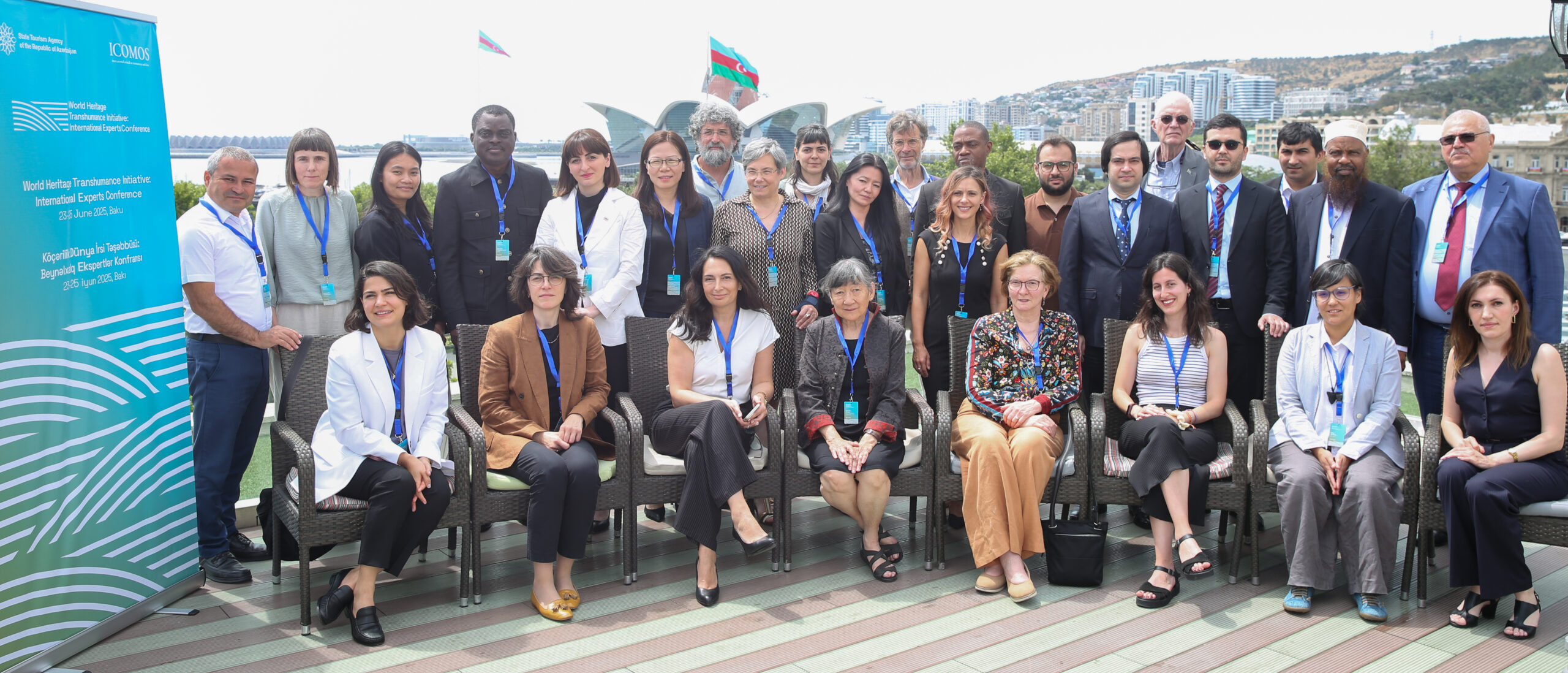Image above: Elizabeth Brabec (front row, fifth from left) with attendees of the Transhumance Experts Meeting, Baku, June 23rd to 25th, 2025 (State Tourism Agency of the Republic of Azerbaijan).
Elizabeth Brabec, ISCCL President
The country of Azerbaijan, comparable in size to Portugal, is a study in spectacular cultural and natural landscapes: the 40,000 year-old rock art of Gobustan, set on distinctive topography on the edge of the Caspian Sea; the region of mud volcanoes as a natural and cultural feature; the fire temples of Zoroastrianism; and the Cultural Landscape of Khinalig people and the “Köç Yolu” Transhumance Route, inscribed in the World Heritage List in 2023.
It is this last cultural landscape that is the impetus for holding this meeting in Baku under the auspices of the State Tourism Agency of the Republic of Azerbaijan. Our group, as invited experts, owe the State Tourism Agency a huge debt of thanks for their generosity and hospitality in sponsoring this meeting.
This was my first return to Baku and the country of Azerbaijan since the World Heritage Meeting in June of 2019. I was again impressed by the incredibly clean city streets and parks of Baku. Being on the world stage at least twice over the past six years has put the city, and the country of Azerbaijan in the spotlight with the 43rd Session of the World Heritage Committee June 30th to July 10th, 2019, the UN Climate Summit, COP29 November 11th through the 24th, 2024, and the upcoming 13th Session of the World Urban Forum in 2026.
The first day’s presentations led me back to my own heritage as a sheep herder in eastern Canada, and later living on a ranch and herding cattle in the western Canadian province of Alberta. As we considered the landscape and the cultural features that define a transhumance way of life, the questions that emerged revolved around what does it mean to recognize, maintain, protect and respect a way of life that has persisted for over a thousand years? And more broadly, what does it mean for agricultural landscapes in general?
As the various presentations on the first day progressed, the definition of “transhumance” came up repeatedly, identifying a spectrum from hunter transhumance to pastoralist transhumance and farming/ranching at the opposite end of the spectrum. Examples of transhumance practices were identified by FAO expert Pedro Herrera Calvo in all of the regions of the world: Europe e.g. in the Carpathians, Alps and the Mediterranean; the Arctic e.g.the Sami; the Middle East and North Africa e.g. the Levant, Turkey; Central Asia and the Himalayas; Latin America e.g. the Andes and Mexico; the Sahel and East Africa; South Asia; and North America e.g. the Diné.
Transhumance is a practice that expands the idea of a “cultural landscape,” through the specialities/disciplines that are required for understanding the system, the identification of features, and the palimpsest of layers of change. Not only do we need to be good heritage specialists, archaeologists, and ethnographers, but also governance and legal specialists, and agricultural specialists. Transhumance is one of the perfect examples of the necessity of co-creation of knowledge between cultural heritage specialists and transhumance practitioners, and the inclusion of all the voices of the routes. The inscription of transhumance under the Convention for the Safeguarding of the Intangible Cultural Heritage, reinforces the critical importance of Indigenous and traditional knowledge in transhumance practice embedded in cultural landscapes.
One question that we must ask, is “what do the people who practice transhumance, want/need to continue their lifestyle?” The answers will depend on who you ask (getting everyone to the table), the questions you ask (can you ask people in a way they can understand and relate to), and who is listening (we all come with our own implicit bias and we listen with our own filters on the world; e.g. talk to a lawyer, and they will think in terms of the law).
Within the governance structures of transhumance systems, the concepts of “common land” play a key role in management systems. As an academic who is trained in law and holds a Juris Doctor in the US, this is the piece of the cultural landscape that I find fundamental to the practice of transhumance and its continuation. If access to the land, land rights, and land ownership are compromised or lost, there can be no transhumance system. So while relevant legal concepts exist in various countries’ common law, regulation and legal codification, these concepts are not routinely understood as applicable to the land access and rights of the transhumance system. As Hussein Mahmoud and Undargaa Sandagsuren both stated, national protocols can enable or constrain the protection of the transhumance way of life.
Finally, transhumance is, or can be, and adaptive strategy for climate change. The Indigenous and traditional knowledge inherent in these systems is often reflective of adaptation to harsh and changing climates. So while the world climate changes and becomes more erratic, the system and practice of transhumance can be a critical adaptive practice and body of knowledge that will add food and agricultural products to a stressed production system. The distribution of food and agricultural products currently happens not just locally, but regionally and internationally; these products and food are seen as being particularly desirable for heritage, organic and religious reasons.

